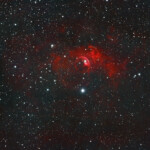NGC 7635, also known as the Bubble Nebula, Sharpless 162, or Caldwell 11, is an H II region emission nebula in the constellation Cassiopeia. It lies close to the direction of the open cluster Messier 52. The “bubble” is created by the stellar wind from a massive hot, 8.7 magnitude young central star, SAO 20575. The nebula is near a giant molecular cloud which contains the expansion of the bubble nebula while itself being excited by the hot central star, causing it to glow.

NGC 7635, Bubble Nebula
NGC 7635, also known as the Bubble Nebula, Sharpless 162, or Caldwell 11, is an H II region emission nebula in the constellation Cassiopeia. It lies close to the direction of the open cluster Messier 52. The “bubble” is created by the stellar wind from a massive hot, 8.7 magnitude young central star, SAO 20575. The nebula is near a giant molecular cloud which contains the expansion of the bubble nebula while itself being excited by the hot central star, causing it to glow.
Photographed with MN190 reflector telescope and Atik 360EX monochrome CCD camera in Stuvsta, March 2022. Exposure was 15*2min RGB each and 15*3min Lum.

NGC 7635, Bubble Nebula
Photographed with the RC8″ reflector telescope and the ASI 2600MC CMOS color camera in Stuvsta, December 12th, 2024. Exposure was 29 * 3 min and 20 * 4 min with IDAS LPS D2 lihgt pollution filter in bright moonlight. Post-processing in Pixinsight.

NGC 7635, Bubble Nebula
Photographed with the RC8″ reflector telescope and the ASI 2600MC CMOS color camera in Stuvsta, December 12th, 2024. Exposure was 29 * 3 min and 20 * 4 min with IDAS LPS D2 lihgt pollution filter in bright moonlight. Post-processing in Pixinsight.

NGC 7635, Bubble Nebula
Photographed with the MN 190 mm reflector telescope and the Atik 360EX monchrome CCD camera in Stuvsta on November 21st, 2025. Exposure was 30 min for each of R, G, and B, and 60 min for Ha. Postprocessing in Pixinsight with Blur Xterminator and in Photoshop to add star spikes.

NGC 7635, Bubble Nebula
Photographed with the MN 190 mm reflector telescope and the Atik 360EX monchrome CCD camera in Stuvsta on November 21st, 2025. Exposure was 30 min for each of R, G, and B, 40 min L, and 60 min for Ha. Postprocessing in Pixinsight with Blur Xterminator and in Photoshop to add star spikes.